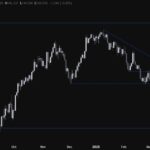
USD/JPY Technical Insights: Navigating Bearish Trends and Mixed Signals
Tháng 4 9, 2025Navigating the Fed’s Rate Cuts: How Stock Market Fluctuations and Tariffs Shape Economic Futures
Tháng 4 9, 2025US Tariffs on European Union Exports: A Deep Dive into Their Impact on Eurozone Growth
The recent economic landscape reveals a critical challenge faced by the Eurozone: the imposition of US tariffs on European Union (EU) exports is poised to exert a far more significant influence on economic growth than initially anticipated. According to new economic reports, the ramifications of these tariffs are causing economists to reconsider their projections for growth across the Eurozone, creating a ripple effect that touches various economic sectors and monetary policies.
Impact on Eurozone Growth Forecasts
Recent analyses indicate that the tariffs imposed by the United States could lead to a substantial downgrade in growth forecasts for the Eurozone. Specifically, experts predict that these tariffs may result in a reduction of Eurozone GDP growth ranging from 0.3 to 0.6 percentage points. This adjustment underscores the extent to which export activities, particularly those targeting the US market, are vital to the overall health of the Eurozone economy. The pronounced decline in exports has prompted economists to reevaluate the growth trajectory, considering the potential for slower economic activity in member countries that are heavily reliant on exports.
The European Central Bank’s Response
In light of these deteriorating economic forecasts, the European Central Bank (ECB) is poised to adjust its monetary policy settings. Market observers believe that the central bank may accelerate its rate-cutting cycle, with a potential cut anticipated as early as April. Such moves are essential to combat the rising disinflationary pressures within the Eurozone. The ongoing economic challenges, heightened by trade tensions, have led markets to price in multiple rate cuts throughout the year, reflecting a growing consensus that a more accommodative monetary policy may be necessary to stimulate growth and stabilize investor sentiment.
Trade War Fears and Market Volatility
The repercussions of the tariffs extend beyond just GDP estimations; they have intensified fears of a broader trade war between the US and the EU. The prospect of escalating tariffs has injected volatility into global markets, adversely affecting European stocks. Notably, sectors that are export-dependent, such as automotive and manufacturing, have seen significant declines. Investors are increasingly concerned about the sustainability of profits in these areas, prompting a cautious approach to asset allocations.
Retaliatory Measures and Ongoing Negotiations
In response to the tariffs, the EU is taking defensive measures by preparing retaliatory strategies against US imports. However, the US administration has warned that additional tariffs could follow if countries decide to respond. This dynamic creates an environment of uncertainty that complicates negotiations between the two economic powerhouses. While there is potential for diplomatic engagement to mitigate the adverse effects of the tariffs, the unpredictability surrounding these discussions leaves the Eurozone economy in a precarious position.
For more insights into international economic relations, particularly concerning China and the implications for global trade dynamics, check out this article: Three Strategic Moves by China’s Xi
Conclusion: Weakened Economic Outlook
In summary, the economic outlook for the Eurozone has notably weakened due to the imposition of US tariffs on EU exports. The implications extend beyond mere GDP projections, as they influence monetary policy decisions and exacerbate concerns over trade relations. Moving forward, the Eurozone faces a significant crossroads as it endeavors to navigate these challenges amid an evolving global economic landscape. Understanding the developments and their implications will be crucial for stakeholders monitoring the region’s economic resilience.
